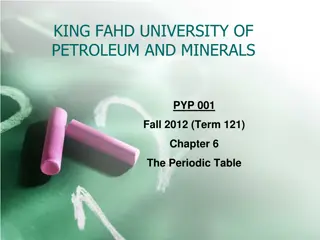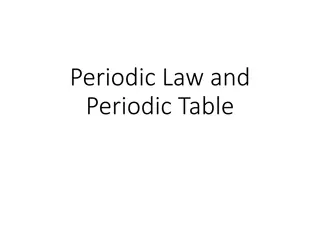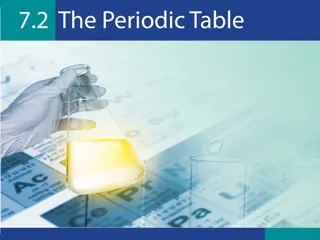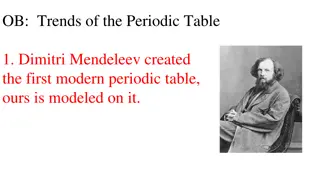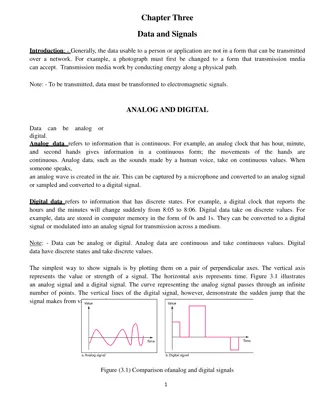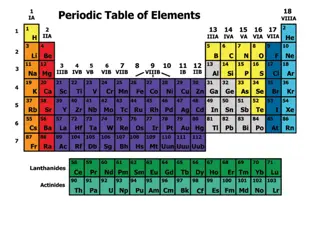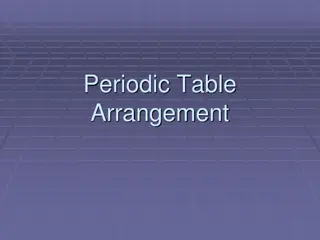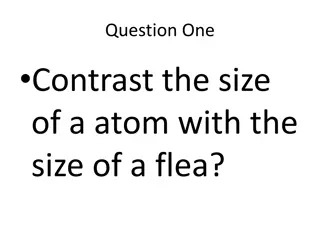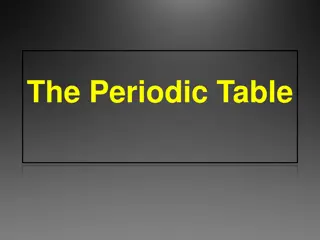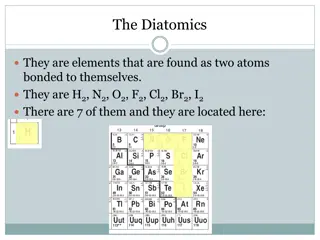Evolution of Periodic Table: From Dobereiner's Triads to Modern Classification
Explore the historical journey of the Periodic Table, starting from the early attempts by Al-Razi and Lavoisier to the concept of Dobereiner's Triads, which paved the way for modern element classification based on properties and atomic masses.
Download Presentation

Please find below an Image/Link to download the presentation.
The content on the website is provided AS IS for your information and personal use only. It may not be sold, licensed, or shared on other websites without obtaining consent from the author. Download presentation by click this link. If you encounter any issues during the download, it is possible that the publisher has removed the file from their server.
E N D
Presentation Transcript
History of Periodic Table History of Periodic Table BS Chemistry Lahore College for Women University, Lahore
Development of Periodic Table Development of Periodic Table First attempt to arrange elements and compounds on the basis of their origin was made by Al-Razi. In 1789 Lavoiser also arranged elements into four groups. Group 1: gases= Oxygen, Nitrogen Group 2:elements forming acidic oxides= S, P Group 3: Metals= Cu, Zn, Sn, Pb Group 4: Salt forming substances= Ca, Ba, Mg, Si
Dobereiners Triads Dobereiner s Triads Dobereiner s triads were groups of elements with similar properties that were identified by the German chemist Johann Wolfgang Dobereiner. He observed that groups of three elements (triads) could be formed in which all the elements shared similar physical and chemical properties. Dobereiner stated in his law of triads that the arithmetic mean of the atomic masses of the first and third element in a triad would be approximately equal to the atomic mass of the second element in that triad
Dobereiners Triads Dobereiner s Triads . He also suggested that this law could be extended for other quantifiable properties of elements, such as density. The first of Dobereiner s triads was identified in the year 1817 and was constituted by the alkaline earth metals calcium, strontium, and barium. Three more triads were identified by the year 1829. These triads are tabulated below
Triad 1 Triad 1 This triad was made up of the alkali metals lithium, sodium, and potassium. The arithmetic mean of the masses of potassium and lithium corresponds to 23.02, which is almost equal to the atomic mass of sodium. Atomic Masses Triad Lithium 6.94 Sodium 22.99 Potassium 39.1
Triad 2 Triad 2 As mentioned earlier, calcium, barium, and strontium formed another one of Dobereiner s triads The mean of the masses of barium and calcium corresponds to 88.7. Triad Atomic Masses . Calcium 40.1 Strontium 87.6 Barium 137.3
Triad Atomic Masses Triad 3 The halogens chlorine, bromine, and iodine constituted one of the triads. The mean value of the atomic masses of chlorine and iodine is 81.1 Chlorine 35.4 Bromine 79.9 Iodine 126.9
Triad Atomic Masses Triad 4 The fourth triad was formed by the elements sulfur, selenium, and tellurium. Sulfur 32.1 Selenium 78.9 Tellurium 127.6 The arithmetic mean of the masses of the first and third elements in this triad corresponds to 79.85.
Triad Atomic Masses Triad 5 Iron, cobalt, and nickel constituted the last of Dobereiner s triads. Iron 55.8 Cobalt 58.9 Nickel 58.7 However, the mean of the atomic masses of iron and nickel corresponds to 57.3.
Limitations of Dobereiners Triads The key shortcomings of Dobereiner s method of classifying elements are listed below. The identification of new elements made this model obsolete. Newly discovered elements did not fit into the triads. Only a total of 5 Dobereiner s triads were identified. Even several known elements did not fit into any of the triads. Owing to these shortcomings, other methods of classifying elements were developed.
Newlands Law of Octaves Newland s Law of Octaves In the year 1864, the British chemist John Newlands attempted the 62 elements known at that time. He arranged them in an ascending order based on their atomic masses and observed that every 8th element had similar properties. On the basis of this observation, Newland s law of octaves was formulated. The law of octaves states that every eighth element has similar properties when the elements are arranged in the increasing order of their atomic masses. An illustration detailing the elements holding similar properties as per Newland s law of octaves is provided below.
Newlands Law of Octaves Newland s Law of Octaves
Newlands compared the similarity between the elements to the octaves of music, where every eighth note is comparable to the first. This was the first attempt at assigning an atomic number to each element. However, this method of classifying elements was met with a lot of resistance in the scientific community.
Limitations of Newlands Law of Octaves The key shortcomings of Newland s law of octaves are listed below. Several elements were fit into the same slots in Newland s periodic classification. For example, cobalt and nickel were placed in the same slot. Elements with dissimilar properties were grouped together. For example, the halogens were grouped with some metals such as cobalt, nickel, and platinum. Newland s law of octaves held true only for elements up to calcium. Elements with greater atomic masses could not be accommodated into octaves. The elements that were discovered later could not be fit into the octave pattern. Therefore, this method of classifying elements did not leave any room for the discovery of new elements.
Meyers Atomic Volume Curve Meyer s Atomic Volume Curve Meyer is best known for his part in the periodic classification of the elements. He noted, as J. A. R. Newlands did in England, if each element is arranged in the order of their atomic weights, they fall into groups of similar chemical and physical properties repeated at periodic intervals. According to him, if the atomic weights were plotted as ordinates and the atomic volumes as abscissae the curve obtained a series of maxima and minima the most electro-positive elements appearing at the peaks of the curve in the order of their atomic weights
Lothar Meyer's periodic table, published in "Die modernen Theorien der Chemie" (1864)
Meyer's table with vertical display of periods in Meyer's table with vertical display of periods in 1870 1870 I II III IV V VI VII VIII IX B Al In(?) Tl C Si Sn Pb Ti Zr N P As Sb Bi V Nb Ta O S Se Cr Mo W F Cl Br I Mn Fe Co Ni Ru Rh Pd Os Ir Pt Li Na K Rb Cs Cu Ag Au Be Mg Ca Sr Ba Zn Cd Hg
Mendeleev's Periodic Table In 1869, Russian chemist and teacher Dmitri Mendeleev (1836 - 1907) published a periodic table of the elements. The following year, German chemist Lothar Meyer independently published a very similar table. Mendeleev is generally given more credit than Meyer because his table was published first and because of several key insights that he made regarding the table.
Mendeleev was writing a chemistry textbook for his students and wanted to organize all of the known elements at that time according to their chemical properties. He famously organized the information for each element onto separate note cards that were then easy to rearrange as needed. He discovered that when he placed them in order of increasing atomic mass, certain similarities in chemical behavior repeated at regular intervals. This type of a repeating pattern is called "periodic". A pendulum that swings back and forth in a given time interval is periodic, as is the movement of the moon around the Earth.
In the figure above, atomic mass increases from top to bottom of vertical columns, with successive columns going left to right. As a result, elements that are in the same horizontal row are groups of elements that were known to exhibit similar chemical properties. One of Mendeleev's insights is illustrated by the elements tellurium (Te) and iodine (I) . Notice that tellurium is listed before iodine even though its atomic mass is higher. Mendeleev reversed the order because he knew that the properties of iodine were much more similar to those of fluorine (F) , chlorine (Cl) , and bromine (Br) than they were to oxygen (O) , sulfur (S) , and selenium (Se) . He simply assumed that there was an error in the determination of one or both of the atomic masses. As we will see shortly, this turned out not to be the case, but Mendeleev was indeed correct to group these two elements as he did.
Notice that there are several places in the table that have no chemical symbol, but are instead labeled with a question mark. Between zinc (Zn) and arsenic (As) are two such missing elements. Mendeleev believed that elements with atomic masses of 68 and 70 would eventually be discovered and that they would fit chemically into each of those spaces. Listed in the table below are other properties that Mendeleev predicted for the first of these two missing elements, which he called "eka-aluminum", compared with the element gallium.
The element gallium was discovered four years after the publication of Mendeleev's table, and its properties matched up remarkably well with eka-aluminum, fitting into the table exactly where he had predicted. This was also the case with the element that followed gallium, which was named eventually germanium. Mendeleev's periodic table gained wide acceptance with the scientific community and earned him credit as the discoverer of the periodic law. Element number 101, synthesized in 1955, is named mendelevium after the founder of the periodic table. It would, however, be several years after Mendeleev died before the several discrepancies with the atomic masses could be explained and before the reasons behind the repetition of chemical properties could be fully explained.
Summary The elements, if arranged according to their atomic weight, exhibit an apparent periodicity of properties. Elements which are similar regarding their chemical properties either have similar atomic weights (e.g., Pt, Ir, Os) or have their atomic weights increasing regularly (e.g., K, Rb, Cs). The arrangement of the elements in groups of elements in the order of their atomic weights corresponds to their so-called valencies, as well as, to some extent, to their distinctive chemical properties; as is apparent among other series in that of Li, Be, B, C, N, O, and F. The elements which are the most widely diffused have small atomic weights.
The magnitude of the atomic weight determines the character of the element, just as the magnitude of the molecule determines the character of a compound body. We must expect the discovery of many yet unknown elements for example, two elements, analogous to aluminium and silicon, whose atomic weights would be between 65 and 75. The atomic weight of an element may sometimes be amended by a knowledge of those of its contiguous elements. Thus the atomic weight of tellurium must lie between 123 and 126, and cannot be 128. (Tellurium's atomic weight is 127.6, and Mendeleev was incorrect in his assumption that atomic weight must increase with position within a period.) Certain characteristic properties of elements can be foretold from their atomic weights.
Dmitri Mendeleev is often referred to as the Father of the Periodic Table the Periodic Table. He called his table or matrix, "the Periodic System" Periodic System" Father of "the
Various limitations of Mendeleev's periodic table are:- Position of hydrogen - he couldn't assign a correct position to hydrogen as it showed properties of both alkali and halogens . Position of isotopes - he considered that the properties of elements are a function of their atomic masses. Hence isotopes of a same element couldn't be placed. In the d-block , elements with lower atomic number were placed before higher atomic number. Lanthanoids and actinoinds couldn't be assigned any location. There was no space for inert gases. Various non metals were placed with the metals in the periodic table
Henry Moseley. Reproduced courtesy of the Library and Information Centre, The Royal Society of Chemistry.
Atomic Number and Modern Periodic Law It wasn t until 1913, six years after Mendeleev s death that the final piece of the puzzle fell into place. The periodic table was arranged by atomic mass, and this nearly always gives the same order as the atomic number. However, there were some exceptions (like iodine and tellurium, see above), which didn t work. Nuclear Charge: Z=1/2(atomic Weight)
. Figure: A sketch of an X-ray tube. X-rays are emitted from the tungsten target Figure 8.6.5 : X-ray transitions in an atom.
Figure: X-ray spectrum from a silver target. The peaks correspond to characteristic frequencies of X-rays emitted by silver when struck by an electron beam.
Atomic Number and Modern Periodic Law He fired the newly-developed X-ray gun at samples of the elements, and measured the wavelength of X-rays given. He used this to calculate the frequency and found that when the square root of this frequency was plotted against atomic number, the graph showed a perfect straight line. He d found a way to actually measure atomic number. When the First World War broke out, Moseley turned down a position as a professor at Oxford and became an officer in the Royal Engineers. He was killed by a sniper in Turkey in August 15, and many people think that Britain lost a future Nobel prize winner.
Atomic Number and Modern Periodic Law Within 10 years of his work, the structure of the atom had been determined through the work of many prominent scientists of the day, and this explained further why Moseley s X-rays corresponded so well with atomic number. The idea behind the explanation is that when an electron falls from a higher energy level to a lower one, the energy is released as electromagnetic waves, in this case X-rays. The amount of energy that is given out depends on how strongly the electrons are attracted to the nucleus. The more protons an atom has in its nucleus, the more strongly the electrons will be attracted and the more energy will be given out. As we know, atomic number is also known as proton number, and it is the amount of protons that determine the energy of the X-rays.
Moseley's problem was to find a linear relationship between the atomic number and a measureable property of the nucleus. The atomic number increased by steps of one (18, 19, 20, 21, and so on). Moseley needed some function of a nuclear property that increased in the same pattern, that is, by one for each element in turn. He found it in the K line of the X ray spectra of each element. It turns out that the square root of the frequency moves by a constant value for each one unit move by the atomic number. The graph was linear, with the frequency square root value moving up the same amount for each one unit jump in the atomic number.
After years of searching, at last we had a periodic table that really worked, and the fact that we still use it today is testament to the huge achievement of these and many other great minds of the last two centuries of scientific discovery.
Features of periodic table Features of periodic table It consists of 7 horizontal periods. The lengths of the periods increase with the order of the period. Elements in a period have consecutive atomic numbers. The 1st period is the shortest period. It consists of just two elements H and He . The 2nd and the 3rd periods have 8 elements each and are called short periods. The 4th and the 5th periods are long periods and have 18 elements each. The 6th period has 32 elements. The period has a 15 element series called lanthanide series, separated from the table. The lanthanide series elements are rare earth elements that show similar properties. The 7th period contains all the rest of the elements. It is incomplete. This period also has a 15 element series called the actinide series, separated from the table. The actinide series have a separate identity and contain uranium and most of the known transuranic elements.
Features of periodic table Features of periodic table The vertical columns are called groups. There are 18 groups in the periodic table. Elements in a group do not have consecutive atomic numbers. The groups are divided into A and B groups. Group IA to VIII A has all the normal elements. Group IB to VIII B holds all the transition metal elements. The other two groups are the lanthanide and the actinide series. They are also known as inner transition elements.
Features of periodic table Features of periodic table The modern periodic table is approximately divided into metals and non metals. The most metallic elements such as alkali metals are on the left hand side. The non metals are on the right hand side. The inert gases or the noble gases with their completely filled electronic shells are placed on the extreme right hand side. The transition metals, which are a bridge between highly metallic alkali elements and the non metals, lie in the center of the table. Lanthanide and actinide series (or the inner transition elements), which have metal like behavior, and are kept separately as their outermost electronic configurations, differ from the transition metal elements.
Nomenclature of Elements of Atomic Numbers greater Nomenclature of Elements of Atomic Numbers greater than 100 than 100 1. The name is derived directly from the atomic number of the element using the following numerical roots: 0 = nil 3 = tri 6 = hex 9 = enn 1 = un 4 = quad 7 = sept 2 = bi 5 = pent 8 = oct 2. The roots are put together in the order of the digits which make up the atomic number and terminated by 'ium' to spell out the name. The final 'n' of 'enn' is elided when it occurs before 'nil', and the final 'i' of 'bi' and of 'tri' when it occurs before 'ium'. 3. The symbol of the element is composed of the initial letters of the numerical roots which make up the name. 4. The root 'un' is pronounced with a long 'u', to rhyme with 'moon'. In the element names each root is to be pronounced separately.
Nomenclature of Elements of Atomic Numbers greater than 100 Nomenclature of Elements of Atomic Numbers greater than 100 Atomic 111 Unununium 112 Ununbium 113 Ununtrium 114 Ununquadium 115 Ununpentium 116 Ununhexium 117 Ununseptium 118 Ununoctium 119 Ununennium 120 Unbinilium 121 Unbiunium 130 Untrinilium 140 Unquadnilium 150 Unpentnilium Uuu Uub Uut Uuq Uup Uuh Uus Uuo Uue Ubn Ubu Utn Uqn Upn number Name Symbol 101 Mendelevium (Unnilunium) Md* 102 Nobelium (Unnilbium) No* 103 Lawrencium (Unniltrium) Lr* 104 Unnilquadium Unq 105 Unnilpentium Unp 106 Unnilhexium Unh 107 Unnilseptium Uns 108 Unniloctium Uno 109 Unnilennium Une 110 Ununnilium Uun




